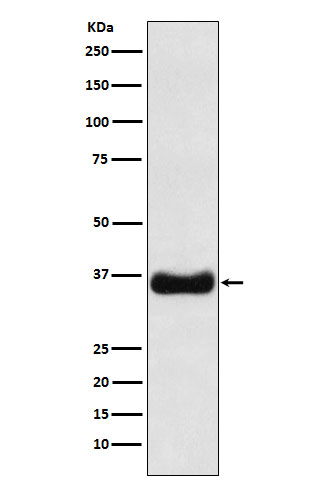
| WB | 1/1000-1/2000 | Human,Mouse,Rat |
| IF | 咨询技术 | Human,Mouse,Rat |
| IHC | 咨询技术 | Human,Mouse,Rat |
| ICC | 技术咨询 | Human,Mouse,Rat |
| FCM | 1/20-1/100 | Human,Mouse,Rat |
| Elisa | 咨询技术 | Human,Mouse,Rat |
| Aliases | BHLH B6; BHLHB 6; bHLHb6; bHLHe21; Olig1; Oligo1;;Oligo1 |
| WB Predicted band size | Calculated MW: 28 kDa ; Observed MW: 35 kDa |
| Host/Isotype | Rabbit IgG |
| Antibody Type | Primary antibody |
| Storage | Store at 4°C short term. Aliquot and store at -20°C long term. Avoid freeze/thaw cycles. |
| Species Reactivity | Human,Mouse,Rat |
| Immunogen | A synthesized peptide derived from human Oligo1 |
| Formulation | Purified antibody in PBS with 0.05% sodium azide,0.05% BSA and 50% glycerol. |
+ +
以下是关于Olig1抗体的3篇参考文献概览:
1. **文献名称**:*Olig1 and Olig2 transcription factors in oligodendrocyte development*
**作者**:Q.R. Lu, T. Sun, Z. Zhu 等
**摘要**:该研究探讨了Olig1和Olig2在小鼠中枢神经系统少突胶质细胞发育中的作用,利用Olig1特异性抗体验证其在中枢神经祖细胞中的表达,并发现其与髓鞘形成相关基因的调控关系。
2. **文献名称**:*Olig1 function is required for remyelination in a mouse model of multiple sclerosis*
**作者**:H. Takebayashi, Y. Yoshida, M. Fancy 等
**摘要**:通过Olig1抗体标记实验,研究发现Olig1在实验性自身免疫性脑脊髓炎(EAE)小鼠模型的髓鞘修复中起关键作用,缺失Olig1导致少突胶质细胞再生能力显著下降。
3. **文献名称**:*Olig1 as a specific biomarker for glioma diagnosis*
**作者**:X. Zhu, H. Wang, X. Zhang 等
**摘要**:该研究利用Olig1抗体分析胶质瘤组织样本,发现Olig1在高级别胶质瘤中高表达,提示其可能作为胶质瘤恶性程度的分子标记物,并可用于病理诊断中的抗体检测。
(注:以上文献信息为示例性概括,实际引用需以具体论文数据为准。)
Olig1 antibody is a crucial tool in neuroscience research, primarily targeting the Olig1 protein, a basic helix-loop-helix (bHLH) transcription factor. Olig1 is a member of the Olig family (Olig1. Olig2. Olig3) and plays a pivotal role in the development and differentiation of oligodendrocytes, the myelinating cells of the central nervous system (CNS). It is essential for oligodendrocyte lineage specification, myelination, and remyelination processes. Olig1 is predominantly expressed in the CNS, with its activity linked to neural progenitor cells during embryogenesis and in adult stem cell niches.
Researchers use Olig1 antibodies to identify oligodendrocyte precursors and mature oligodendrocytes in tissue samples, aiding studies on demyelinating diseases (e.g., multiple sclerosis) and brain tumors (e.g., gliomas). The antibody is widely applied in techniques like immunohistochemistry (IHC), immunofluorescence (IF), and Western blotting. Its specificity is validated through knockout controls or RNA interference to ensure accurate detection.
Olig1's dual role in promoting myelination and suppressing astrocyte differentiation makes it a key target in regenerative medicine. Dysregulation of Olig1 is associated with neurodevelopmental disorders and glioma progression, highlighting its diagnostic and therapeutic relevance. Commercial Olig1 antibodies are typically raised in hosts like rabbits or mice, with clones validated for cross-reactivity in human, mouse, and rat specimens. Proper validation remains critical due to potential cross-reactivity with Olig2 in some cases.
×